Salisbury (Sarum) Probus Club
Sarum Probus Club is an organisation for retired men living in the Salisbury Area.
Previous Meetings 2022
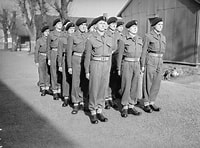
On 10th February 2022
John
Ball, a Club member, gave a talk on his experiences in National Service 1957-9.
John fell behind at School due to difficulties in his family life. On leaving
School he had tried a variety of jobs but only low paid, low skilled work was
available to him so National Service came as something of a relief.
As a recruit he was placed with those training as medics but first he had to improve his basic education, something which proved much more enjoyable than he had expected.
From Church Crookham he was sent to 2 Paras at Aldershot. There he continued his medical training and learnt how to jump from a plane. In the Field Ambulance Unit he went first to Gibraltar where he worked in the Military Hospital as a Nurse Orderly and had a very enjoyable time. John played many sports; cricket, football, basketball with British, American and Canadian servicemen. His training was in great demand, dealing sometimes with injuries caused by fights, sometimes with illnesses like Avian flu. The experience was invaluable.
Eventually John was told to move with his platoon to Beirut but circumstances changed and he finished up in Benghazi. Here they were working with the Royal Sussex Regiment. On one occasion his unit had to search for a crashed American plane and the horrific sights John saw stayed with him long afterwards.
On another occasion the group was taken out to the desert on
exercise. The desert was a forbidding place, inhospitable and covered with rocks
and stones. The idea was that the soldiers would make their way back by the
stars but unfortunately the stars forgot to shine, and the group quickly became
lost. Fortunately, they were found by Bedouin who were very hospitable but had
to be carefully watched, especially as the men had guns which the desert
dwellers might well kill for.
Eventually John returned to Gibraltar and soon afterwards the two years’ Service
came to an end. John finished as a Sergeant which showed he was appreciated by
his superiors, and he has always been grateful for the educational improvement
and the start on a medical career which those Army years gave him.
The
questions that followed showed how interested members were. In particular
members wondered how National Service might benefit the youth of today.
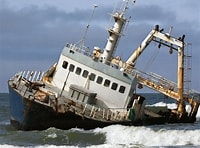
On 25th February 2022
Kevin Patience introduced his subject “A Career in Commercial Diving and Marine Salvage.” Kevin’s interest in diving began as a boy, where he lived in Kenya. A book given him by his father gave a very romantic view of diving and intrigued the young Kevin.
When he joined the air force, he was introduced to scuba diving and visited some spitfire wrecks off Malta. Back in Africa he was able to find freelance work inspecting and photographing underwater wrecks in Mombasa. From this he moved to overseeing the salvage and cutting up of wrecks, the first of which was the Globe Star in 1975.
Work then took him to the Persian Gulf where he did a variety of jobs including the inspection of oil pipelines for leaks.
Then he decided to start his own salvage company with two colleagues. They were able to employ several techniques in the raising of sunken vessels in particular that invented by Ernest Cox, which involved sealing any holes with concrete or plastic filler and then injecting compressed air to disperse water inside the vessel.
Kevin described a whole range of ships his company rescued, including work for the American Navy. They specialised in working on small ships like Chinese junks and sand barges – vessels that larger companies were not interested in.
Kevin’s career was divided between Africa and Bahrain with spells of work in each. The work was often dangerous with serious risks, but the development of more sophisticated diving suits and other equipment meant Kevin and his colleagues survived many close encounters and lived to tell the tale. And what an exciting tale it is.
The talk was very well presented and illustrated, and members were clearly impressed.

We were shown the difference between human brains and animal brains with the former enlarged by a neocortex on top of the common areas other creatures share. The common areas we share with other mammals largely control automatic things like heart and lungs. The neocortex contains the neurons and synapses which give humans intelligence.
In the past the brain was thought to function by receiving inputs from ears, eyes etc in separate chunks which it assembled in the part of the neocortex relevant to that input. The various parts of an image say were added in a hierarchy of features until the full picture emerged.
Jeff Hawkins believes this view of the brain working is too static and rather favours the view that the neocortex contains billions of neurons stacked in columns, each having a complete sensory system, which store models of objects built up over time. Columns pass information to each other and so construct an agreed picture of the information being processed. Each is lik
e a brain in itself, hence the title of his book “A Thousand Brains.” Dieter then discussed the question of Artificial Intelligence and the problems associated with handling vast data sets which have to be updated frequently. At the moment AI runs on a fairly static process of accessing and handling data. We are nowhere near reproducing the brain’s system of dynamic interaction between neuro columns.
Dieter emphasised that the brain remains a puzzle and the puzzling features grow the more the subject is researched and studied but the movement from a static idea of brain function to a dynamic one is truly a breakthrough and will doubtless lead to all sorts of developments in the future.
Dieter urged us to read Jeff Hawkins’s book to understand more but we were not advised to read it at bedtime.
Again a very well presented talk which kept everyone's interest.

The title of Alan’s talk was “Tales of a Roving Reporter.” Alan had always wanted to be a broadcast journalist but, when he was first seeking work, jobs in that field were scarce. He was therefore very surprised when the BBC offered him a job in Radio, and he was soon able to work from Southampton through central Southern England. This was ideal for Alan as he lived in the New Forest.
Using a van bristling with aerials, one of which could be raised to 30 ft, he travelled the area and conducted over the years about 25,000 interviews.
There were amusing moments, such as the time he was mistaken for a TV Licence enforcer, embarrassing moments, like the time he was asked to report on a Nudist fund raising event, and scary moments as when he had to climb the side of an American warship to interview the captain.
Alan told of some of the difficulties live reporters face. Often getting to the event took longer than expected and he had to go on air in a scheduled slot with no preparation. At other events the unexpected happened as when the Bishop of Portsmouth, apparently afraid of heights, disappeared from the top of his recently finished Cathedral so quickly that there was hardly time for a few words, let alone the hoped-for interview.
Timing was everything and events were so tightly planned that if there was a delay for some reason radio introductions had to be revised on the hoof. There was no time for second takes.
One thing was clear – the life of a roving radio reporter was and probably still is far from dull.
The talk was most entertaining, and all were grateful to Alan for stepping in at the last moment and giving such a professional presentation.

Over the space of two years they took photographs of countless wild flowers growing around the Britford area of Salisbury. We were amazed that there were so many species, dazzled by the quality of the photographs taken on an iphone (by no means the latest model) and inspired by the fact that they were able to produce a quality video knowing very little about wild flowers before they began.
It was a testimony to their ingenuity – discovering apps that could assist them in identifying plants, and their determination to see the project to completion by discovering in a second season what they had overlooked in the first. The photographs were all taken by John and Mary as they walked the area for healthy exercise.
We are promised a sequel next year on the plants around Lime Kiln Way, an area only a mile or so from Britford but with a markedly different fauna. We look forward to that. The talk led others to describe how they had filled the weeks and months of lockdown.
This was a very informative and well presented talk.

Then followed a fascinating talk on the most scenic route to Snowdon, (avoiding the motorways) with the aid of some wonderful slides highlighting the remoteness and beauty of the area. Gwynedd has a population half that of Wiltshire but with more sheep than human beings.
In 1787 the development of the slate mines transformed the whole area, sadly it closed in 1961 but remains the home of a great many goats most of whom are friendly to the visitors. The narrow gauge slate mine railway is still used for the benefit of visitors, while still using some of the original engines.
Mike gave a very vivid explanation about Snowden itself where he had spent at least one visit a year over the past forty years.
Among the interesting things seen en route is the underground Hydro Electric Power Station which can be accessed by the public.
With Snowden rising to 3,560 feet, weather changes are one of the biggest hazards as Mike found out while climbing some of the several paths to the top. It is much easier if less glamorous to ride up on the railway which has an incline of 1 in 5.5. It was started in 1894 and runs the 4.7 miles from Llanberis to the summit its final cost was £7 million. Mikes explanation of the complexities of the horizontal cogwheel system was amazing and created a great deal of discussion.
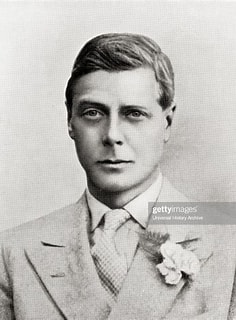
On 13th May 2022 Steve Herra gave a talk entitled “The Prince’s Murderous Mistress”.
The story began when the Prince of Wales met Marie Marguerite Alibert during his time in France during the 1914-18 War. Marie had been living with Andre Mellor. The relationship was stormy as Marie had a fierce temper but, as Andre was very rich, Marie had a high-class apartment.
She first met the Prince in Paris while he was on leave in 1917 and very soon he was invited to her apartment. The relationship lasted less than two years but, during that time, the Prince had written many letters to Marie in which he made unguarded comments about the War and his father, King George V. Were these letters to be made public the scandal would have done immense damage.
The Prince duly passed on to another passion, Freda Dudley Ward, and he hoped Marie would either destroy or return the offending letters but she didn’t. Instead, she sent the Prince a letter reminding him about them and made it clear she planned to keep them.
She meanwhile had further lovers, becoming still richer through at least one husband, and finally marrying Ali Fahmy, a wealthy Egyptian aristocrat.
The relationship broke down with the couple openly fighting wherever they went. Eventually they came to England in 1923 and checked in to the Savoy Hotel. There were arguments and then, at 2 am a night porter heard three shots and rushed to the scene.
Marie confessed to him and to three other people that she had shot Ali. Indeed, he had been shot in the back and it seemed like a clear-cut case of murder.
But Marie had the Prince’s letters. An attempt was made to get some back before Marie’s trial and a settlement was reached but several letters remained.
At the trial the Prosecutor concentrated on assassinating Ali’s character and omitted the strongest arguments that would have convicted Marie. The Defence argued Ali had become ferocious and claimed Marie was defending herself.
The Jury returned a verdict of “Not Guilty.” Probus members felt undoubtedly it was a fixed trial and that the Defence Barrister and indeed the Judge had shown a clear bias in favour of Marie. Ali was portrayed as a fierce, bad-tempered foreigner who took advantage of a vulnerable young woman. Undoubtedly the letters played a part behind the scenes and they were destroyed after the trial. Marie went on to live to be 80, having been married and divorced 5 times.

He showed us examples of this style almost at its purest in several buildings in the Cathedral Close. But even in the purest there were variations in detail as each architect added his own personal touches. .
In Salisbury many older buildings were refaced in a Georgian style and several Georgian buildings were later embellished with Victorian features. The Georgian style persisted in Salisbury for longer than in places like London where the later Victorian developments caught on more quickly.
Richard went on to show us many interesting buildings in the grounds of Wilton House. He had acquired much of his knowledge through working as a stonemason on many of the places described. It was a very interesting and absorbing talk.
He expressed the doubts many have that the bodies found below a staircase in 1674 are the remains of the Princes and, along with this, doubts that Richard III was responsible for their deaths at all.
Various other candidates were explored as possible murderers along with the possibility the young Princes were not murdered at all but secreted out of the Tower, to Yorkshire in the case of Edward, and to Burgundy in the case of Richard. The claims of later “Pretenders” were explored with the real possibility that Perkin Warbeck was truly Richard IV.
More documentation is needed to support these claims and permission to DNA test the bones stored in Westminster Abbey would answer at least some of the questions and help solve the mystery.
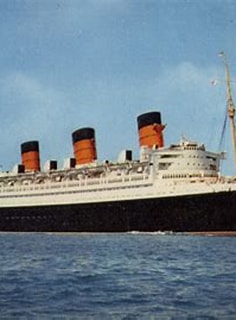
In 1838 The Company was formed by Canadian born Samuel Cunard who with the aid of two financial backers secured a Government contract to carry mail to Boston USA. Prior to this the journey took 6 weeks to cross the Atlantic and shipping losses were one in six ships.
The first of his four ships was named Britannia and made the crossing in 13 days carrying as well as passengers a cow and chickens. Charles Dickens one of the earlier famous passengers was sick all the way sleeping on a very hard mattress in the top bunk.
In 1870 The SS Parthia was built s smaller ship but with two bathtubs In 1880 all lighting was electric In 1907 The first of the 4 funnel ships named SS Mauritania was put into service having turbine engines thus giving more space for leisure activities including elevators.
SS Carpathia was awarded the BOSTON Trophy for rescuing 705 survivors from the Titanic. This Trophy is always on display in the flag ship of the fleet. Aquitania was the last of the 4 funnel ships and was fitted out as a luxury mansion and carried nearly all famous movie stars at one time or another. This was mainly because the main USA port became New York as Boston iced up in the winter, at the same time
Cunard established their Head Office in Liverpool, subsequently moving to Southampton.
In 1930 over 3,000 shipbuilders were employed building the joint venture ship of the Cunard-White Star line named Queen Mary a real luxury liner with shops and Ballroom at which Henry Hall was the dance band leader launched on 27th May 1936. It carried 16,000 troops on one trip in WW2 Queen Mary became a hotel in USA and the Queen Elizabeth sank after catching fire in Hong Kong Harbour, while being converted to a university. QE2 is a hotel in Dubai. In 1980 Cunard became part of the American Carnival Group.
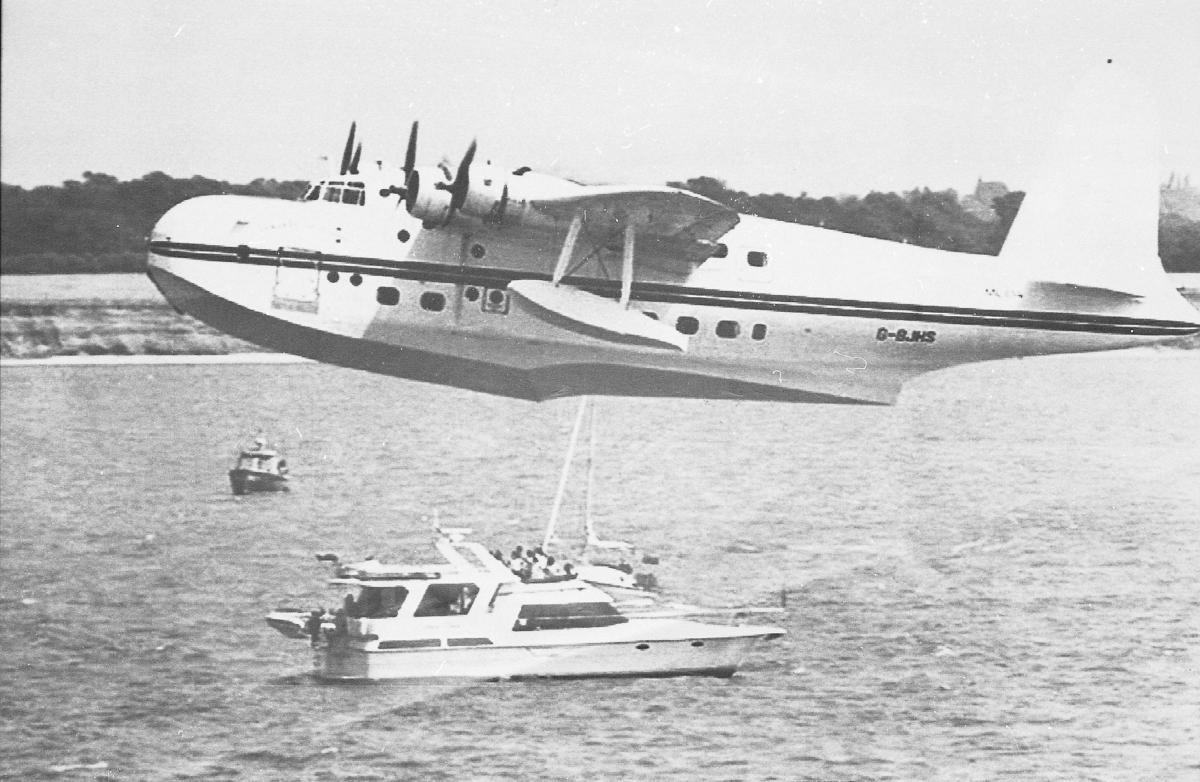
The talk was based on the part played by Pool Harbour in the development of aviation in the period 1939—1947.
Such was the quality and breadth of the talk; the following resume gives but the briefest of summaries.
Starting of course with the first aviator Sam Cody and his local connections up until his fatal air crash in local woodlands.
Mr Rolls of Rolls Royce fame who was born in Southbourne saw the future development of flying but unfortunately, he was also killed in a plane crash. His ideals were never the less carried on by Mr Royce
Poole quickly became the main hub for the vast array of Flying Boats developed by Shorts in Havant particularly in carrying mail and passengers around the world. Such was the speed of development that both the Navy and Air Force established bases around Poole.
Kevin’s numerous pictures of the vast array of Flying Boats and Seaplanes served to amplify his in-depth knowledge of the true role played by Aviation in Poole Harbour and its surrounding environs. It’s role in the second world war was brought to bear because of its closeness to Portland as the Gateway to England by German Bombers.
The end of an era came when the last flying boat departed in 1947.
The comments and questions that followed served to show what an interesting and captivating morning it had been.
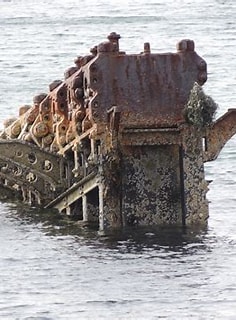
From poor beginnings the Admiralty had made considerable improvements to warships by the outbreak of war in 1914. The German Navy had improved also and during the War the two fleets met at the Battle of Jutland, with a definite victory for the German Navy.
With the defeat of Germany in 1918, 74 Navy ships were interned at Scapa Flow while their future was decided at the ongoing peace talks. Germany was certainly not going to be allowed to keep such prestigious and powerful ships.
The German sailors were disgruntled at their degrading treatment and were glad to learn that their Admiral, Von Reuter, proposed to scuttle them. This was no easy task; it required time and skill to drill the necessary holes, cut the hull metalwork and open various valves.
Admiral Von Reuter took advantage of a Naval exercise drawing the guarding British Warships away to send out a secret coded signal and the ships started to sink, some in shallow, others in much deeper water. This took place om 21st June 1919.
The RN, rushing back managed to beach 18 ships but the other 54 went to the bottom. The British Government decided to leave the ships where they now rested and local people raided them for copper and other salvageable metals.
Ernest Cox, who ran, with his partner and financier, Tommy Danks, a salvage shipbreaking business, bought some of the battleships and successfully raised them using compressed air. His biggest challenge was the Hindenburg but even this he managed to raise finally in 1930.
By 1931 Cox had had enough. He had raised 32 of the Scapa Flow vessels and he sold the salvage rights to another company.
At the moment 7 ships are left on the seabed, some partially dismantled for special metals. The public may still dive to view them but not to remove anything.
Kevin peppered his talk with many interesting asides about his salvage work generally. All felt it was a fascinating talk.

Laverstock Mental Hospital, Salisbury.
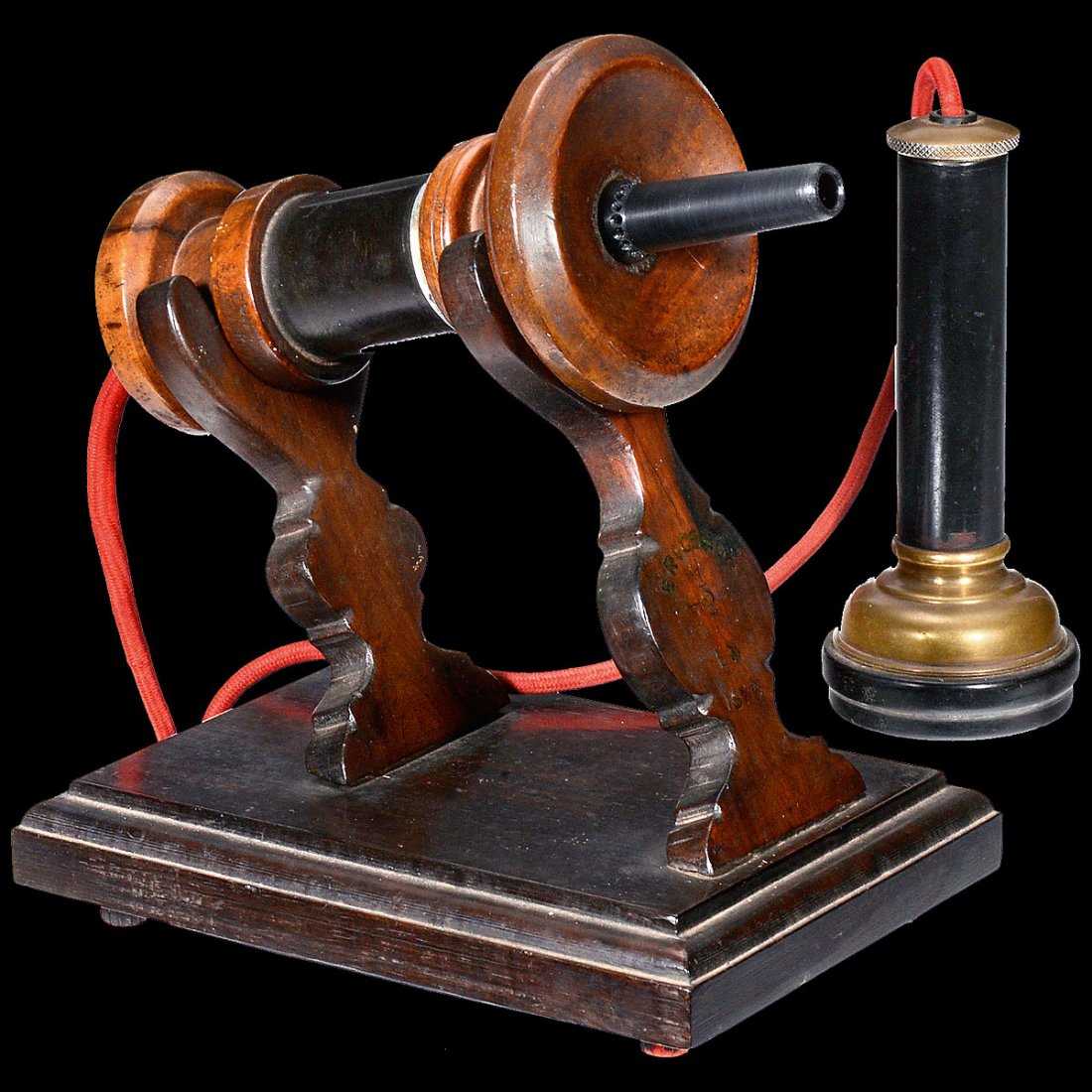
At their November 11 meeting
Probus Club of Sarum welcomed Mr. Andrew Larkham
who gave a lecture about the development of telephony. His talk spanned from
Graham Bell calling his assistant Watson on March 10, 1876 to the present.
The first telephone book in the UK was issued on 15 January 1880. 1912 saw the
first public telephone exchange in UK. Growing numbers of switchboard operators
were needed for the expanding system.
Subscriber Trunk Dialling (STD) was introduced in 1958 to allow subscribers to
dial trunk calls without operator assistance. These had been mechanical and slow.
The invention of dual tone multi frequency was much faster (DTMF) and
superseded STD. This was soon followed by pulse code modulation (pcm), resulting
in the installation of Empress on 11/12/1961, the first pcm exchange in the UK
on a single pair of wires, which could carry up to 24 calls in parallel.
Despite these enormous changes over the years their was no let up in
development.This is now culminating in modern day fibre based broadband systems.
Don’t Die of Embarrassment
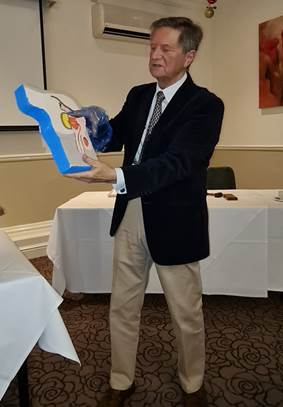
At their November 25 meeting Probus Club of Sarum
welcomed
Mr. Andy Jones, retired BBC reporter. Andy, who had spoken to the Club before
about his long BBC career offered a very contrasting topic this time round. As a
past sufferer from prostate cancer he gave a very erudite and memorable talk
about prostate cancer.
He reminded his audience that in the UK every 45 minutes somebody dies of the
disease. Considering that it may take as long as 15 years before symptoms spread
there is ample scope for improved early intervention.
Andy
used a number of colourful home-made models to give his audience an appreciation
of the physiological intricacies and to illustrate the variety of modern
interventions. He reminded the listeners that
Herophilus, the Alexandrian physician,
first identified and described the prostate gland in the 3rd century
BC. It took nearly 2000 years for European medicine to catch up.
For more previous meetings 2019-21 2021 2021-2 2022 2023 2004 2025
For more recent talks click here